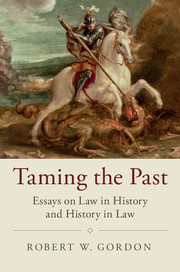Book contents
- Taming the Past
- Studies in Legal History
- Taming the Past
- Copyright page
- Dedication
- Contents
- Foreword
- Permissions
- Introduction
- Part I The Common Law Tradition in Legal Historiography
- Part II Legal Historians
- 3 Social-Legal History’s Pioneer: The Work of James Willard Hurst
- 4 Hurst Recaptured
- 5 Morton Horwitz and his Critics: A Conflict of Narratives
- 6 The Elusive Transformation*
- 7 Method and Politics: Morton Horwitz on Lawyers’ Uses of History
- 8 E. P. Thompson’s Legacies
- 9 The Constitution of Liberal Order at the Troubled Beginnings of the Modern State*
- Part III History and Historicism in Legal History and Argument
- Index
8 - E. P. Thompson’s Legacies
from Part II - Legal Historians
Published online by Cambridge University Press: 13 July 2017
- Taming the Past
- Studies in Legal History
- Taming the Past
- Copyright page
- Dedication
- Contents
- Foreword
- Permissions
- Introduction
- Part I The Common Law Tradition in Legal Historiography
- Part II Legal Historians
- 3 Social-Legal History’s Pioneer: The Work of James Willard Hurst
- 4 Hurst Recaptured
- 5 Morton Horwitz and his Critics: A Conflict of Narratives
- 6 The Elusive Transformation*
- 7 Method and Politics: Morton Horwitz on Lawyers’ Uses of History
- 8 E. P. Thompson’s Legacies
- 9 The Constitution of Liberal Order at the Troubled Beginnings of the Modern State*
- Part III History and Historicism in Legal History and Argument
- Index
Summary
[This short essay appeared in a Symposium organized by the Georgetown Law Review to memorialize E. P. Thompson after his death in August, 1993. 82 Georgetown Law Review 2005 (1994). Thompson did not see himself as a “legal” historian, but was one of the first to recognize that both official law and popular law and custom pervasively structured social relationships, and he exerted a powerful influence on American as well as British social-legal historiography.]
- Type
- Chapter
- Information
- Taming the PastEssays on Law in History and History in Law, pp. 149 - 155Publisher: Cambridge University PressPrint publication year: 2017

